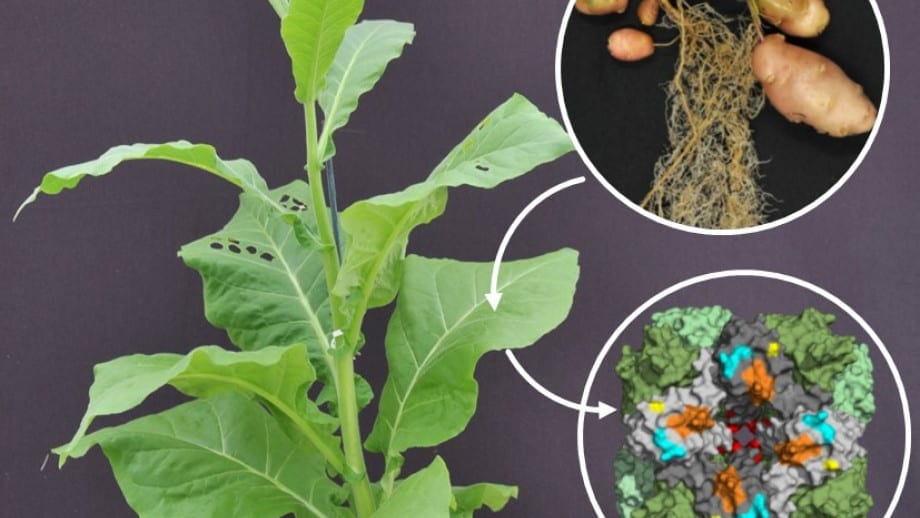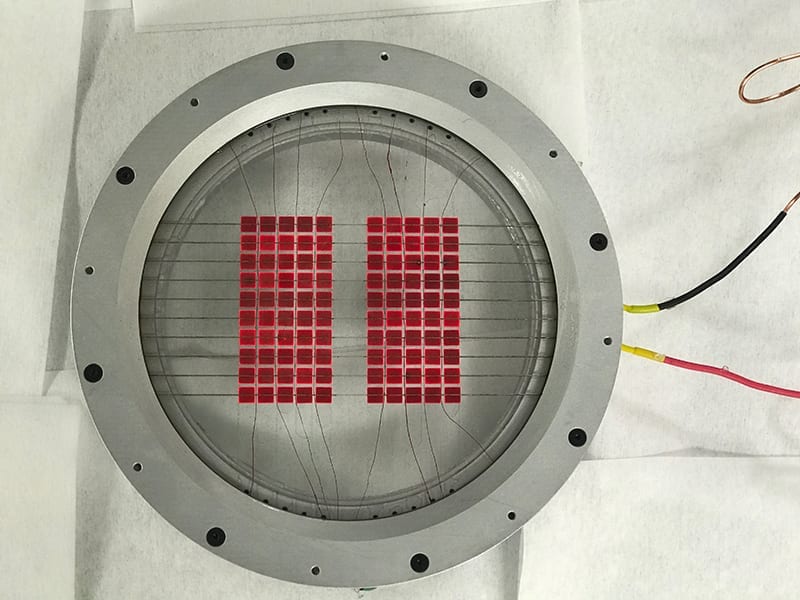
SynBio approach the researchers deciphered how the small subunit influences potato Rubisco catalysis. Image: Elena Martin-Avila, et al
Research led by scientists at The Australian National University (ANU) could lead to major improvements in crop production.
The study shows a new way to help study and ramp up photosynthesis. The breakthrough is based on revisiting an original, billion-year-old strategy in plants.
It looks specifically at rubisco activity – a crucial part of the process according to co-author Professor Spencer Whitney from the ARC Centre of Excellence for Translational Photosynthesis at ANU.
“Rubisco is an enzyme involved in the first step of carbon fixation – it starts the conversion of carbon dioxide into plant sugars,” he said.
“But compared to other enzymes, rubisco is considered a slow, inefficient catalyst.
“Many enzymes can process hundreds to thousands of molecules per second, but rubisco can only get through two to five cycles per second.
“For this reason, it’s long been recognised as a good target for improving photosynthesis — it’s a puzzle scientists have been looking at for decades.”
In plants rubisco is made up of 16 proteins – eight large and eight small subunits. Until now scientists have only been able to tinker with one subunit at a time.
“We’ve now turned back the clock a billion years to rectify this limitation,” Professor Whitney said.
“By reapplying the genome design of the bacterial ancestors of chloroplasts we can now play around with all the components of rubisco simultaneously.
“This is crucial. To ramp up its activity you have to make changes to all the components.”
It could mean big gains for canola and potato crop in particular.
“We know we can already tinker with rubisco activity in these crops, so it’s a great place to start,” Professor Whitney said.
“This is the just the first step – this technology could eventually deliver something much bigger in the not so distant future.”
The Latest Updates from Bing News & Google News
Go deeper with Bing News on:
Crop production
- Drought devastates crops in southern Africa: 'The grain I have is only enough for the next two months'
Seventy percent of southern Africa's maize comes from South Africa. Drought devastates crops in southern Africa: 'The grain I have is only enough for the next two months' first appeared on The Cool ...
- Expert gardener demonstrates 'simple' trick for boosting tomato production: 'I instantly got higher yields'
Thanks to gardening expert Jerra (@jerrasgarden), you can increase your tomato production with this simple hack. The scoop Many tomato plants bloom numerous flowers but do not end up ...
- A Margin Squeeze is Setting in Across Row-Crop Farms, and 80% of Ag Economists Are Now Concerned It'll Accelerate Consolidation
Farmers across the U.S. push forward to plant, and there’s an immense amount of pressure riding on this year’s crop production picture. With a margin squeeze setting in across farms, economists think ...
- Campbell Vaughn: Latest crop of Vidalia onions are now on sale. Learn why they are so special.
Like Girl Scouts with their annual cookie sale fundraiser, some of Georgia’s 230,000 kids involved in UGA’s 4-H program use the sale of Vidalia onions to raise money for scholarships, projects and ...
- Global Wine Market Moving Into Equilibrium With Low Production And Consumption
In 2023, the global wine market experienced its lowest production since 1961, with a drop of 10% to 237.3 million hectoliters, according to the OIV.
Go deeper with Google Headlines on:
Crop production
[google_news title=”” keyword=”crop production” num_posts=”5″ blurb_length=”0″ show_thumb=”left”]
Go deeper with Bing News on:
Improving photosynthesis
- Species living closely together in symbiosis is far older and way more common than you might think
Once known only to those studying biology, the word symbiosis is now widely used. Symbiosis is the intimate relationship of different species living together. It's much more common and older than many ...
- From fighting climate change to reducing air pollution, the benefits of trees in your yard
Trees in Florida's urban areas provide many benefits, including fighting climate change and reducing air pollution. Here's how.
- May's full of opportunities for gardeners ready to go and grow | Sally Scalera
Though we have just begun to receive warm weather, this month is still ideal for gardening. When the weather is nice, who wants to stay inside?
- New NASA satellite monitoring ocean health
PACE will reveal how aerosols might fuel phytoplankton growth in the ocean and help identify harmful algal blooms.
- Long-lived warm up around the corner
Cade Cooper, left, from Powhatan and Amanda Yowell, right, from Culpeper, took advantage of great weather on the first day of summer to float down the James River past a group of sunbathers near the ...
Go deeper with Google Headlines on:
Improving photosynthesis
[google_news title=”” keyword=”improving photosynthesis” num_posts=”5″ blurb_length=”0″ show_thumb=”left”]










